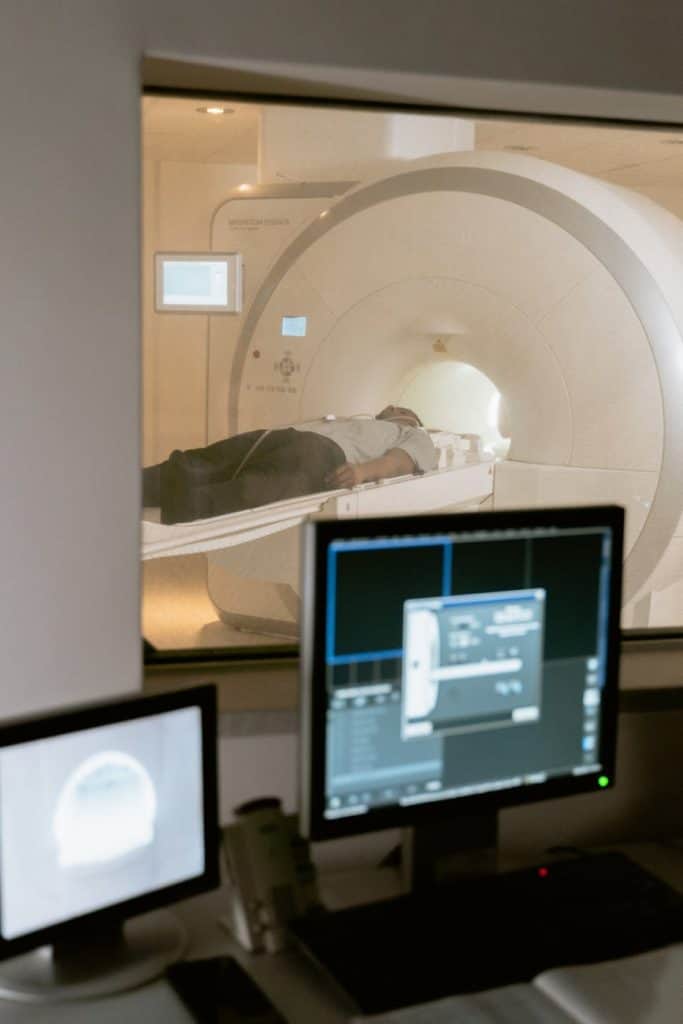Diagnosing asbestos-related diseases requires a comprehensive approach, as conditions such as asbestosis, malignant mesothelioma, and asbestos-related lung cancer often develop years or even decades after initial exposure to asbestos fibers.
Due to the severe health hazards associated with asbestos exposure, timely diagnosis is crucial for managing symptoms, mitigating complications, and improving quality of life.
Asbestos fibers, when inhaled, embed in lung tissue, causing inflammation and scarring over time. This can lead to serious lung conditions such as pulmonary fibrosis, pleural disease, and restrictive lung disease.
Early detection of these conditions through proper diagnostic tools and expert evaluations is essential for effective treatment and symptom management.
Mesothelioma Diagnosing Methods
-
- CT/CAT Scan
-
- Immunohistochemistry (IHC)
-
- MRI
-
- Needle Biopsy
-
- PET scan
-
- Pleuroscopy
-
- Tumor markers/blood test
-
- Chest X-ray

Asbestosis Diagnosis
Asbestosis is caused by asbestos fibers lodged in the body’s vital organs. Asbestosis has no cute and can is not reversible; however, procedures may improve the quality of life. If asbestosis symptoms are severe enough, asking your doctor about surgical options would be advised.
Diagnosing Asbestosis is very similar to diagnosing mesothelioma. Imaging tests such as X-rays, CT scans, or biopsies. Other diagnosing procedures can include a bronchoscopy or a thoracentesis.
Bronchoscopy is a procedure where a tiny camera in a tube passes through your mouth or nose. The camera allows the doctor to observe from the inside. Thoracentesis is when a needle is inserted through your chest to drain any excess fluid.
Asbestosis Symptoms
-
- Chest Pain
-
- Weight loss
-
- Heavy coughing
-
- Difficulty Breathing

Asbestosis Diagnosing Methods
-
- CT/CAT Scan
-
- Immunohistochemistry (IHC)
-
- MRI
-
- Needle Biopsy
-
- PET scan
-
- Pleuroscopy
-
- Tumor markers/blood test
-
- Chest X-ray
-
- Bronchoscopy
Asbestos Lung Cancer
An individual can develop asbestos lung cancer after inhaling asbestos fibers. Once the fibers are inhaled, they can become lodged in the lung tissue, where they may cause cancer.
Experts have estimated that 18% of lung cancers may be caused by exposure to asbestos. In the United States, an estimated 2,000-3,200 people die from asbestos lung cancer yearly.
Once an individual has inhaled asbestos, there is a latency period between exposure and onset of lung cancer, but others have been as little as three years or as long as thirty. Some latency periods have been ten and half years between exposure and development.
There are two types of lung cancer caused by asbestos. The first is called small cell lung cancer, and the second is non-small cell lung cancer. The majority of all lung cancers are non-small cell lung cancer.
Symptoms of Asbestos Lung Cancer
-
- Chest pain or discomfort
-
- Coughing up blood
-
- Chronic respiratory infections
-
- Fatigue
-
- Hoarseness
-
- Loss of appetite
-
- Neck and/or face swelling
-
- Persistent coughing
-
- Shortness of breath
-
- Wheezing

Asbestos Lung Cancer Treatments
-
- Surgery
-
- Chemotherapy
-
- Radiation Therapy
-
- Immunotherapy
Pleural Plaque Diagnosis
Pleural plaques are the thickening of the pleura. Pleural plaques are formed by asbestos fibers lodged in the lining of the lungs. Asbestosis takes years after a patient’s initial exposure to form. The pleura membrane lines the lungs and inner ribcage of the body.
There are no symptoms associated with pleural plaques. People with Pleural plaques are often more challenging to diagnose due to their asymptomatic nature. It is found through biopsies, X-rays, or CT scans.
Pleural Plaques and asbestosis are not the same things. They are not cancerous and are considered harmless. Suppose you have received a Pleural Plaques Diagnosis.
In that case, you should not be alarmed, somewhat aware of the higher risk of further asbestos damage to your lungs.
Typical Jobs with a higher risk of exposure and a Pleural plaques diagnosis are firefighters, construction workers, boilermakers, factory employees, industrial workers, miners, veterans, and shipbuilders.
Pleural Plaques Treatment
-
- Avoid further exposure to asbestos
-
- Quit smoking
-
- Avoid Pollution

I Think I Have an Asbestos-Related Illness. What Should I Do?
-
- If you think you may have an asbestos-related illness, you should contact your general practitioner and try to trace back your exposure and symptom history.
-
- Try to think of your symptoms and the period in which they began to occur.
-
- Have your symptoms progressively worsened?
-
- Have you been exposed to asbestos, and did you work with the material routinely?
-
- Do you have any factors that would increase your risk of developing lung cancer? (ex. Do you smoke?)
Seek Justice For Asbestos Exposure
If you’ve been diagnosed with an asbestos-related disease such as asbestosis, mesothelioma, or lung cancer, your health may have been compromised due to negligent asbestos exposure.
Symptoms like persistent dry cough, chest pain, or shortness of breath often stem from unsafe workplaces, defective products, or environmental contamination.
Our attorneys specialize in helping victims of asbestos exposure secure compensation for medical bills, lost wages, and emotional suffering. We work to hold negligent employers, manufacturers, and property owners accountable.
Contact us today for a free consultation to discuss your case and learn how we can help you pursue justice and financial support.

